If you’re serious about elevating your songwriting and guitar playing skills, expanding your chord vocabulary is a crucial step. Understanding and utilizing a variety of chords will not only enrich your musical expression but also open up new avenues for creativity on your acoustic guitar.
This guide provides comprehensive Acoustic Guitar Chords Charts, ranging from essential open chords perfect for beginners to more advanced and alternative tunings that seasoned players will appreciate. By exploring these charts, you’ll build a stronger musical foundation and discover your unique voice on the acoustic guitar. Let’s dive in and explore the world of acoustic guitar chords!
Essential Open Chords for Acoustic Guitar
For those just starting their guitar journey, open chords are typically the first chords learned. These chords are called “open” because they incorporate open strings, meaning strings that are not fretted. Common examples of open chords include C major, A major, and E minor.
Once you’ve grasped the fundamental open chords, exploring variations can add depth and intrigue to your playing. The charts below introduce some excellent variations that aren’t overly complex but offer fresh and inspiring sounds. Chords like Em7 and Cadd9 are widely used and add a touch of sophistication, while Em9 and A6sus2 are less common, possessing a lush, bittersweet quality that can elevate your music.
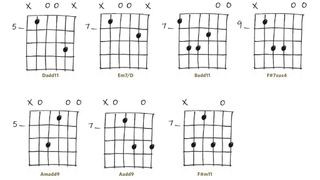 Open chords chart
Open chords chart
(Image credit: Future) – Acoustic guitar open chords chart for beginners and intermediate players.
We’ve arranged these four chords into a simple strumming pattern for practice, but the real magic happens when you experiment with incorporating them into your own chord progressions. Try substituting them for basic major or minor chords to add color and texture to your songs.
Sus Chords: Add Spice to Your Acoustic Progressions
In music theory, major and minor chords are the two foundational chord types. Major chords generally evoke feelings of happiness and brightness, while minor chords tend to sound darker and melancholic.
Suspended chords, or “sus” chords, offer a unique alternative. They are neither major nor minor, possessing a neutral and ambiguous quality. This characteristic makes them incredibly useful for injecting dynamism and a sense of movement into otherwise straightforward chord progressions on your acoustic guitar.
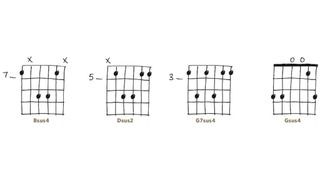 Sus chords chart
Sus chords chart
(Image credit: Future) – Acoustic guitar sus chords chart demonstrating Bsus4, Asus4, Gsus4, and Dsus4.
Experiment with these sus chord shapes and try alternating them with basic major and minor chords that share the same root note. For instance, transitioning from Bsus4 to B major or Asus4 to A major creates a pleasing and natural resolution. Sus chords often sound particularly effective when played immediately before a major or minor chord with the same root.
Blues Chords for Acoustic Guitar: Inject Soul into Your Playing
In the blues genre, dominant 7th chords take center stage, becoming more prevalent than standard major, minor, and sus chords. Dominant 7th chords like A7 and D7 are essential building blocks for blues progressions.
The A7, D7, and E9 chord shapes presented in the chart below provide everything you need to start improvising a 12-bar blues in the key of A on your acoustic guitar. For a more edgy and jazzy flavor, explore A13 and E7#9 chords, which work beautifully in both blues and jazz contexts.
Bm7 is your go-to chord for creating a moody minor blues feel. When improvising over a Bm7 chord, try utilizing the D7 shape shifted up four frets to create a classic Bm7 to F#7 chord progression, a staple in minor blues.
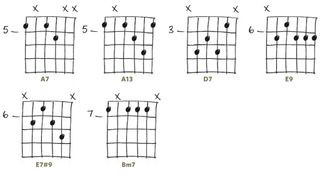 Blues chords chart
Blues chords chart
(Image credit: Future) – Acoustic guitar blues chords chart including A7, D7, E9, A13, E7#9, and Bm7.
The example provided utilizes a fingerstyle approach with added single notes and string mutes (indicated by ‘X’) between chords, creating a sparse and authentic bluesy texture. This technique adds rhythmic interest and emphasizes the bluesy character of the chords.
Mid-Neck Open Chords: Expanding Your Acoustic Palette
You’re likely already familiar with open chords in the first position – C, A, G, E, D, and their minor counterparts played near the guitar’s headstock.
However, a powerful technique to expand your acoustic guitar chord vocabulary is to adapt and move these familiar open chord shapes up the neck. By retaining one, two, or even more open strings while fretting notes higher up the fretboard, you can create entirely new chords and sonic textures. Experiment with the chords shown in the chart and then try sliding these shapes to different positions on the neck.
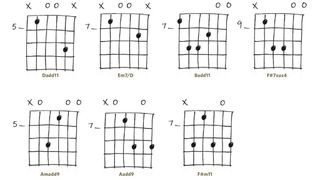 Mid-neck open chords charts
Mid-neck open chords charts
(Image credit: Future) – Acoustic guitar mid-neck open chords chart showcasing unique chord voicings.
The rich and resonant sounds produced by these mid-neck open chords are a result of the interplay between droning open strings and the wide intervals created between fretted notes and those open strings. This simple approach is incredibly versatile and offers a vast sonic landscape to explore. Don’t hesitate to experiment by moving these shapes around the fretboard and discovering your own unique voicings.
DADGAD Tuning: A World of Acoustic Possibilities
DADGAD tuning is often considered the king of altered tunings, particularly favored by singer-songwriters and folk-style fingerpickers for its rich and evocative sound.
While learning new tunings can initially seem challenging as you adjust to the altered relationships between notes, it’s precisely this change that sparks creativity and leads to unexpected musical discoveries. DADGAD stands out for its user-friendliness and the inspiring sounds it readily unlocks.
The chord chart below provides a starting point for exploring DADGAD tuning. However, the true beauty of DADGAD lies in experimentation. Once you grasp these basic shapes, venture beyond and discover the unique chord voicings and textures this tuning offers.
(Image credit: Future) – Acoustic guitar DADGAD tuning chords chart for alternative acoustic sounds.
Exploring arpeggios and melodic ideas around the chords you learn in DADGAD is highly recommended. The fingerstyle arpeggio example provided is essentially based on a simple D and G chord sequence, demonstrating how familiar chord progressions can take on a new dimension in DADGAD.
CGCGCD Tuning: Unlocking Celtic and Drone-Like Acoustic Sounds
CGCGCD tuning, also known as open Csus2 tuning, is a less widely known but equally captivating cousin of the DADGAD (Dsus4) tuning. It’s a staple in Celtic music and offers exceptional potential for drone-like strumming patterns and deep, resonant bass notes.
Despite its sonic richness, CGCGCD hasn’t achieved the same mainstream popularity as DADGAD. This might be partly due to the need for heavier gauge strings to comfortably reach those lower C notes. However, the unique soundscapes this tuning unlocks are well worth exploring. Try moving the basic C chord shape around the fretboard in CGCGCD to instantly generate rich chord-melody ideas and discover the tuning’s unique voice.
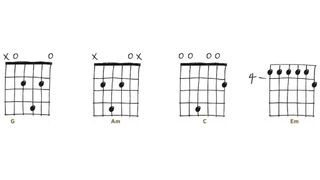 c-tuning chords chart
c-tuning chords chart
(Image credit: Future) – Acoustic guitar CGCGCD tuning chords chart for Celtic and drone music styles.
The chord shape presented in the first two bars of the example is incredibly versatile in CGCGCD tuning. Moving this shape up and down the fretboard yields fantastic sounds in nearly every position. If you only learn one chord shape in CGCGCD, make it this one – it’s a gateway to the tuning’s sonic potential.
By exploring these acoustic guitar chords charts and experimenting with different chord types and tunings, you’ll significantly expand your musical vocabulary and unlock new creative possibilities on your acoustic guitar. Embrace the journey of chord discovery and find your unique acoustic voice!
